


There is a bit of revolution going on in oceanography. Quite quietly, many new robust autonomous platforms are making ocean observations. The revolution has been growing for a decade and now feels like a fresh breeze. Taking humans and ships out of much of the ocean observation loop is enabling new science and pushing aside old ways. It is preparing us for observational challenges in places humans and ships cannot go.
There was recently published a special issue of Oceanography (the Journal of The Oceanography Society) on Autonomous and Lagrangian Platforms and Sensors (ALPS). Here autonomous means “without humans aboard” and Lagrangian means “drifting.” Since ALPS are central to SPURS and the subject of a paper in the special issue, I thought I would give you the basics of the story. What motivations lie behind the use of ALPS in SPURS?
Satellite remote sensing enables observation of many surface properties of the ocean and their evolutions (temperature, salinity, and sea level being prime examples from physical oceanography). Because electromagnetic radiation (light) used for such remote sensing cannot penetrate water, measurements of subsurface properties still require the use of instruments in the water (such as ALPS), deployment mechanisms (such as ships), and oceanographers to design rational deployment strategies. From its origins, the SPURS program has focused on combining remote-sensing observations with autonomous multi-platform research (See prior blog: Measurements by long-term autonomous platforms in SPURS), continuing NASA’s long tradition of autonomous exploration in challenging remote environments with cutting-edge robotics.
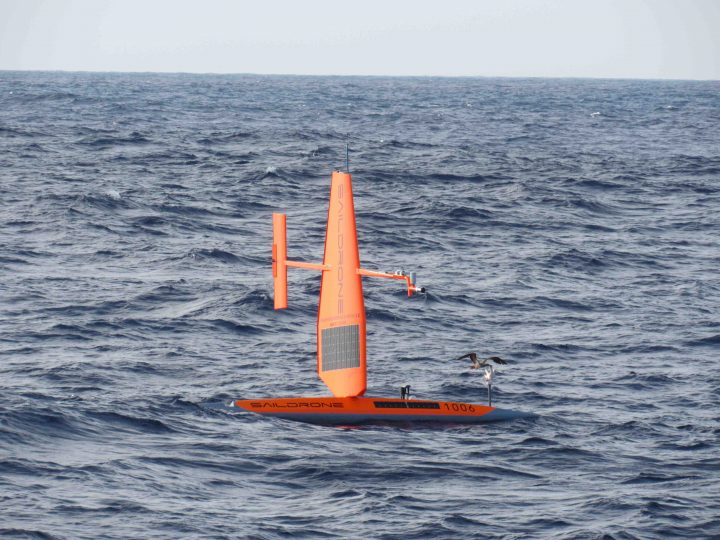
Saildrone with a bird landing.
Shipboard observations in the open ocean are too costly to sustain for than a few weeks; their use is impractical for studying some aspects of seasonal and longer-term evolution of ocean phenomena. Autonomous drifting (Lagrangian) instruments (See prior blog: Mathematicians from the 18th Century) have a niche in mapping the global ocean circulation and upper ocean properties (e.g. Global Drifter Program and Argo Program). The drifting assets in SPURS include deployments of drifters and Argo floats that initially contribute to SPURS but then stay on in the water for many years as part of their global arrays. Mobile autonomous instruments – underwater gliders (See prior blog: Seaglider #189 Away!) or self-propelled surface vehicles (wave, sail, or solar powered) can also provide the capability for sustained and controlled surveys of the upper ocean. The self-propelled vehicles in SPURS include Seagliders, Slocum Electric Gliders with microstructure, Wavegliders, Ecomappers, and Sail Drones. For SPURS-2 the focus on the upper few meters of the ocean has necessitated use of autonomous platforms that can sample the ocean well clear of the disturbances of a large ship.
It remains a central challenge of modern physical oceanography to sample the immense range of temporal and spatial scales relevant to determining and predicting the evolution of ocean properties. Ultimately we need to understand and model, for example, turbulence at microscopic scales, eddies and fronts at kilometer scale, and ocean-basin-spanning currents at 10,000 kilometer scale. The innovative use of a variety of measurement platforms in SPURS is one example of how different tools, each with its own strengths and weaknesses, can be used in a coordinated fashion to ensure broad-scale coverage while resolving important small-scale processes. We get the big picture with satellites but must fill in details with networks of ALPS and the occasional “intense look” by a research vessel acting as a mother ship for a concentrated ALPS fleet.
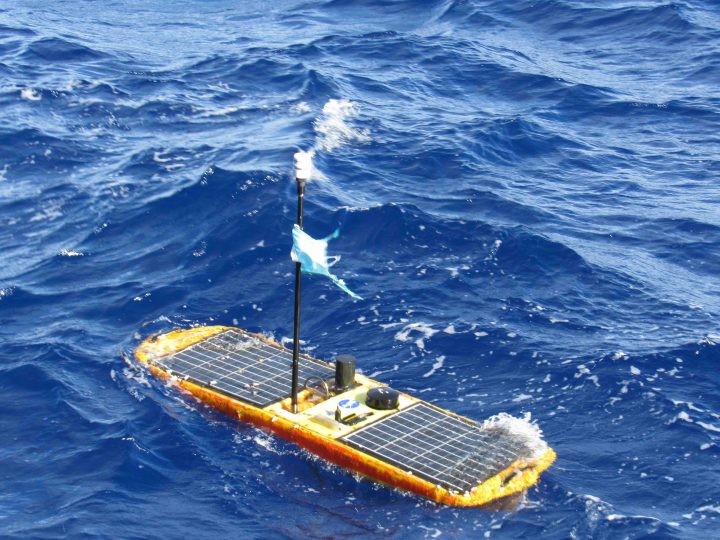
Waveglider ready for recovery after 14 months at sea.
The NASA Physical Oceanography Program is using SPURS to develop effective strategies for sustained ocean observations that use satellites and ALPS together to span the spatial and temporal scales required to address physical processes in the upper ocean – particularly those impacting climate and the water cycle. Ultimately NASA, in many realms, is working to perfect “smart networks” of disparate instruments – sensor webs you might call them – capable of interaction and self-coordination to achieve research and mission objectives. Hopefully we learn well how to explore and protect Earth’s ocean before we are called on to design and build an autonomous sensor web to explore another ocean world. Exploration of oceans on Enceladus, Europa, and others may only be decades away, so we better get moving!

Ecomapper at the ocean surface.
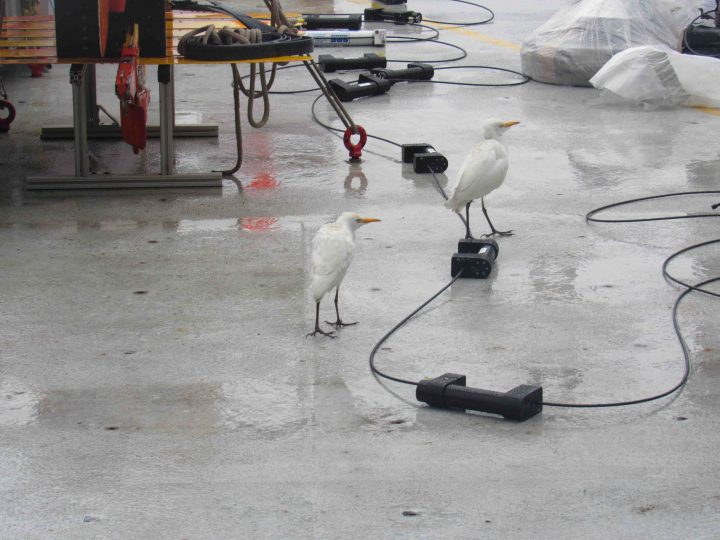
Our Egrets assist with drifter deployment.
We had imagined a grand drifter experiment for SPURS-2. Investigators from a number of institutions contributed drifters that would measure surface temperature and salinity and transmit position via satellite. Each was a different technology and would drift with currents at a different depth. Surface Velocity Program drifters (5), of which there is a global array of 1250 at any one time, are tailored to follow the currents at 15 m depth; CODE drifters (5) follow the currents at 2 m depth; French drifters (5), looking like miniature starships, follow the currents at 1 m depth; and new drifters (20) from Florida State University, looking like film cans from the cinema, follow the current within inches of the ocean surface. It was thought that if we could deploy all of them in about 1 square kilometer of ocean and watch them drift for a day, we could further understand the “shear” in currents near the surface (differences in speed and direction at different levels). With 35 drifters in all at 4 different levels, it seemed like an interesting experiment.
OK, so the immediate problem with this experiment was discovered before any drifters were deployed. Both France and FSU (25 of 35 drifters) use Globalstar positioning system. Although both groups had been assured that this system would work out here in the remote tropical Pacific Ocean, in fact no positioning information could be obtained once the drifters were turned on for testing. How this happened is surely the subject of much email between our investigators ashore and Globalstar. These 25 drifters return home unused. A huge part of the experiment went south without ever touching the water!
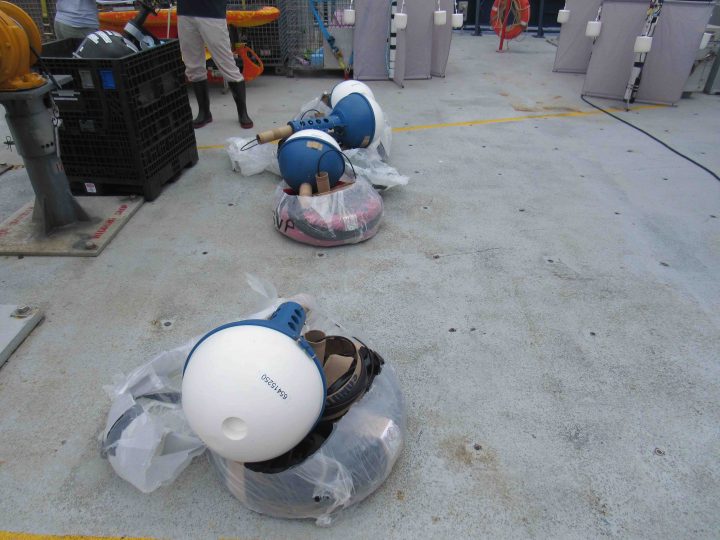
Surface Velocity Program drifers ready for deployment.
Now, we have 10 drifters at 2 levels. Not nearly so interesting. As planned we deployed them close together. The two kinds of drifters stayed together as like kinds and immediately headed off in slightly different directions (of south, funnily enough…). We recovered the CODE drifters after 24 hours and the SVP drifters remain in the water to join their brethren as part of the global array. What did we learn? It was hardly the “big” drifter we expected and the loss of diversity hurt pretty bad. We learned again that this kind of thing happens at sea, the technology of the lab and concept of an experiment runs afoul of reality and the sea. The battle between technology and the sea continues to rage.
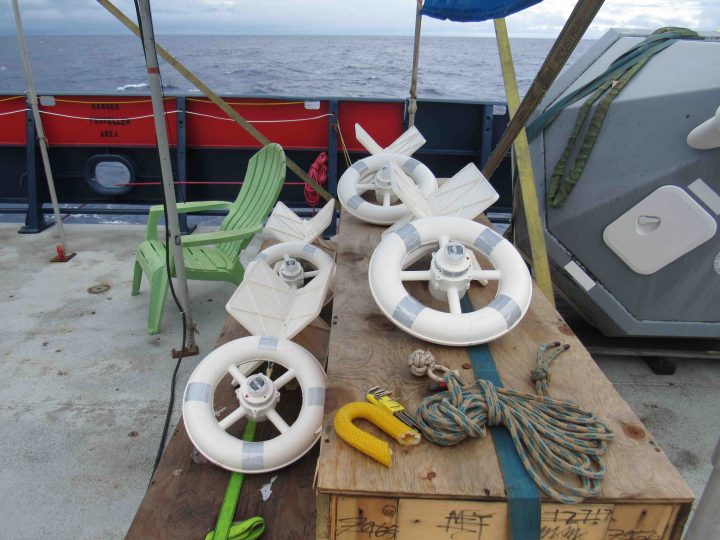
Space-age looking drifters from France ready for deployment.
One person who is deeply disappointed by our drifter experience is Alexandre Supply. He is all set to begin his Ph.D. work and might have been in a good position to analyze the conceptualized drifter experiment. As it stands, he has worked out a new configuration of drifter material for deployment sometime in the next week (a mini-experiment). This will at least allow tests of some technology and some oceanographic data for his collaborators.
Alexandre Supply (at University of Pierre and Marie Curie in Paris) is one of those young scientists who gives us old folks hope for a bright future for our science of physical oceanography. We are lucky that he only thought briefly of studying law and quickly learned that natural science was much more to his liking. He describes being torn between careers in astronomy/space studies or climate – only to discover that he could have it both ways by working on oceanography from space. That is the kind of thinking that brings people into the world of the NASA Earth Science Division!
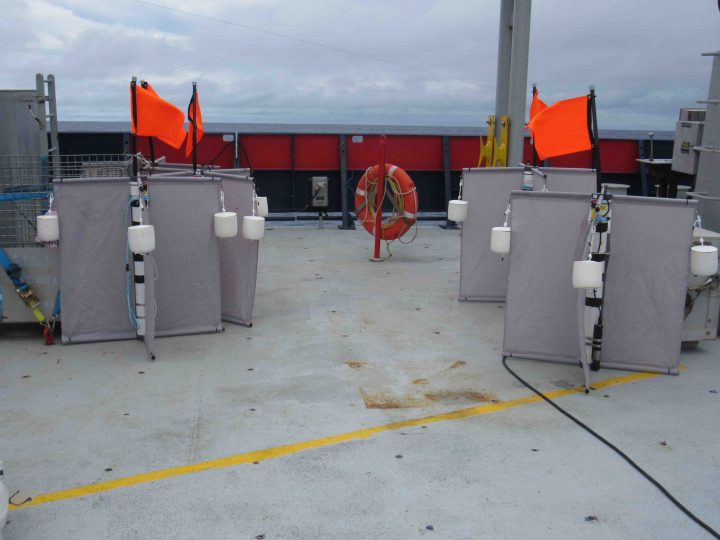
CODE drifters from Scripps ready for deployment.
Alexandre and his fiancé, Anastasia, will both be looking for work in the oceanography-from-space realm once all their academic credentials are completed. They will be a new kind of “power couple” in the field (both with Ph.D.) with deep experience in satellite data analysis and sea-going experience. Their language skills alone are awesome (French, English, and Russian)! I hope they are interested in working with NASA one day.

Alexandre Supply.
Life on an oceanographic research vessel is definitely different than daily life ashore. For the crew there are regular watches, to man the bridge, deck, and engineering. Keep them very busy are the operation and maintenance of the ship, sustenance and safety of all onboard, and fulfilling Revelle’s scientific mission. For the scientific party the work and watches are quite malleable depending on what the main occupation of the day might be. There are four primary activities of a day – working, sleeping, eating, and entertainment.
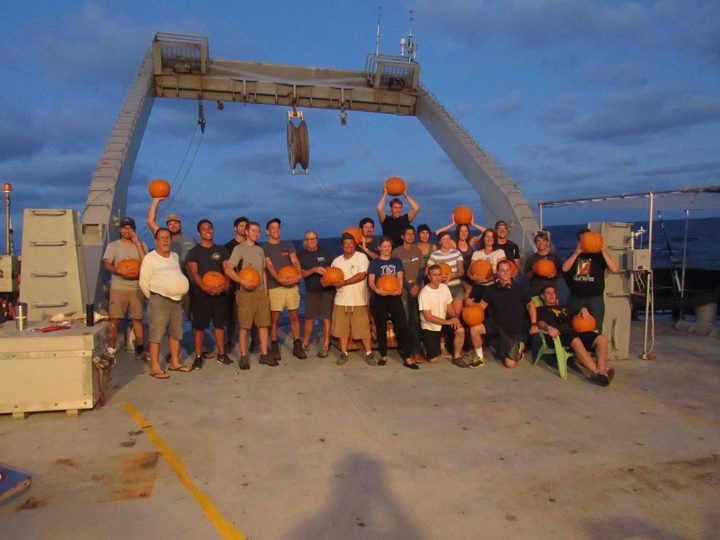
Pumpkin selection for carving contest completed.
Work: There is some work going on at every hour, around the clock. Shifts have been set up to manage the deployments and recoveries of the Surface Salinity Profiler and its associated laser/image experiment. There are three-person shifts around the clock to attend to the Underway CTD. Likewise there are volunteers for the balloon launches (atmospheric sounding) four times per day. The precipitation radar team also will manage 24 hour per day operations as we dedicate a couple weeks of work in the rainiest areas. Someone must always be awake to monitor “autonomous” systems processing water from the sea snake system (more on that during the last week of the voyage).
Sleep: Because of shift work, there may be people asleep at any hour of the day or night. The ship is a noisy place, so it is common to use ear plugs or noise suppressing ear gear. Noise arises from the constant drone of the engine, water slapping the hull of the ship, doors and hatches closing, grinding and sanding on deck, winches, and simply people in close quarters. The opportunity for true silence awaits ashore. It does not occur aboard ship.
Eating: Three meals per day are prepared by Jay and Mike. Breakfast 0730-0815. Lunch 1130-1215. Dinner 1700-1800. The food is plentiful and very well prepared. Sunday dinner is notable as “steak night.” There are options for the vegetarians! Unfortunately, there is inadequate space in the dining area for everyone to sit at once. Those on watch get to eat first, then others follow. The dining motto is “eat it and beat it.” Not very civilized, but necessary! We try hard to be finished and plates cleared by the end of the appointed meal time.
Entertainment: The ship has an extensive library, so there in no shortage of good reading material if one did not bring books from home. There is also a lounge for watching movies. It is quite common for a card game to get going after dinner. Some people bring craft work like knitting for entertainment. There are also opportunistic entertaining events – like the pumpkin carving contest on this expedition or fishing near moorings. There is gym equipment and a weight room for those wishing to work out.
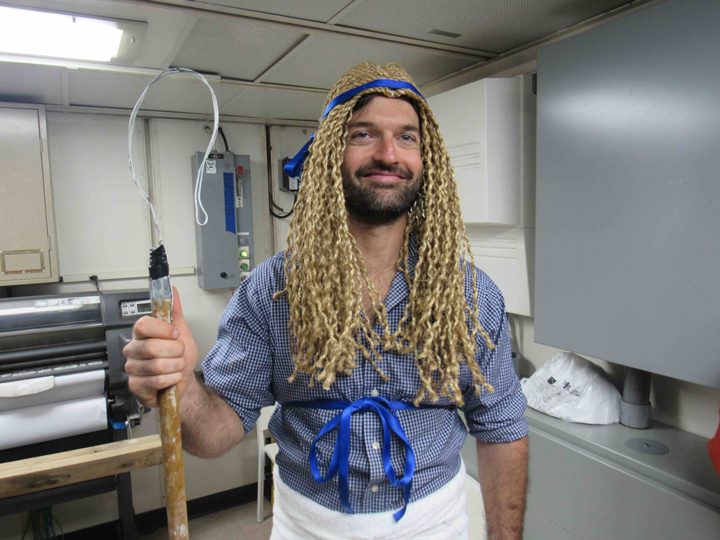
Ben, who minds our flock of drifters.
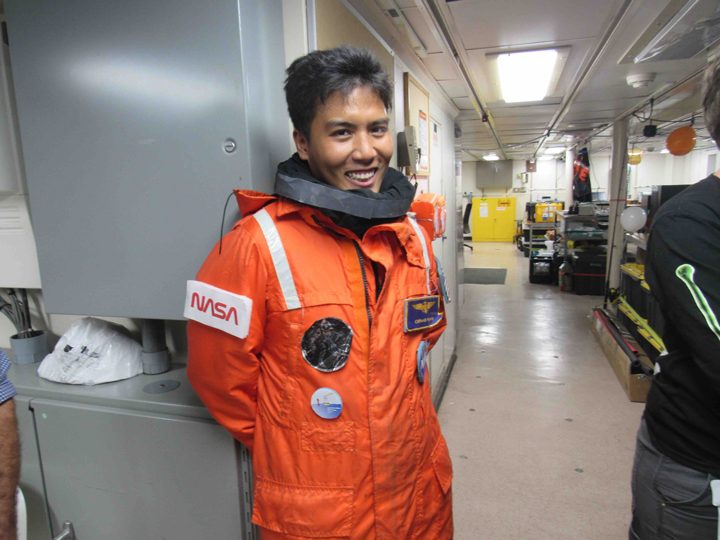
Clifford obviously wants a job at NASA.
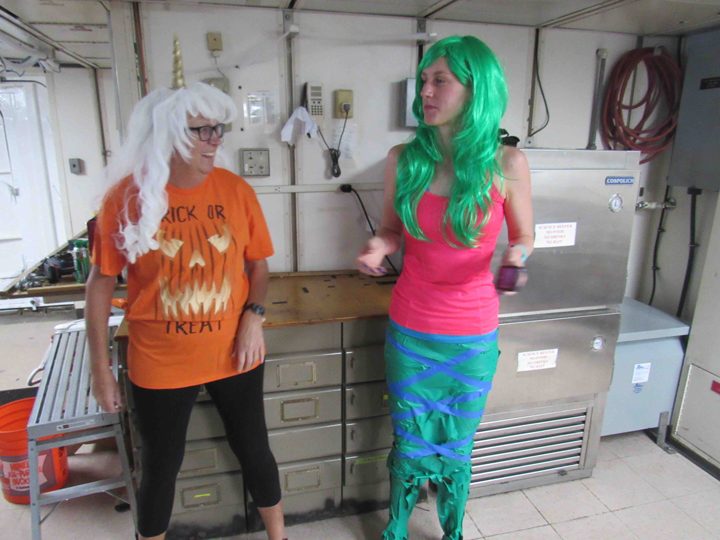
Janet and Elizabeth make a colorful duo.
For scientists at sea there is always the call of work back home. I know that people are reviewing the dissertations of students, preparing journal articles for submission, and preparing proposals to submit for new funding. Your blogger too has such duties – sending out emails to scientists about recently reviewed proposals, preparing for a large ocean conference in 2019, and writing a short article for Oceanography.
This voyage has been blessed with a small side-show by a couple of Egrets. They seemed near death when they joined the ship late last week. After taking on some food and freshwater, thanks to Trina from UW APL, they are taking ownership of the fantail of the ship and providing good entertainment. I will keep you apprised of their situation.
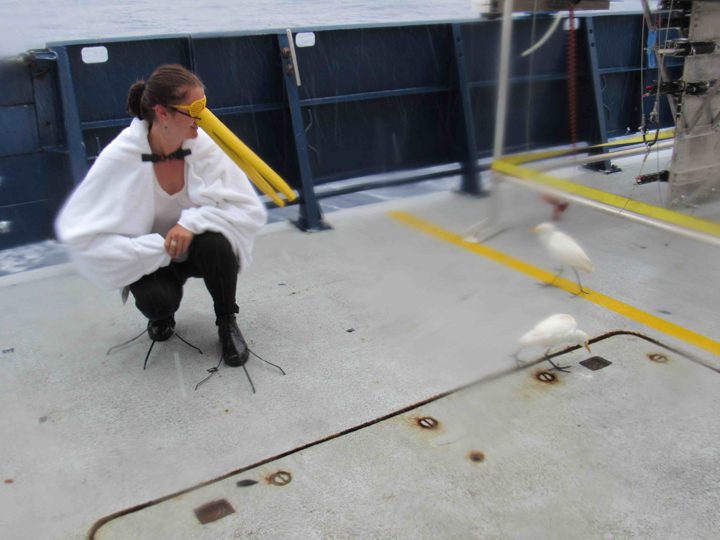
Trina in costume with the egrets.
We had wonderful laughs and a few minutes of fun on Halloween. Costumes were called for while attending the daily science briefing. Photos throughout this blog post capture the moment much better than my words.

Science lecture for the Halloween party!
Last year I wrote a blog detailing the University of Washington team’s Surface Salinity Profiler so I will not repeat myself here. The primary function of this instrument (towed outboard of the ship’s wake) is to gather detailed information on the temperature, salinity, and turbulence structure in the upper meter of the ocean. This is notoriously (for oceanographers) difficult to do directly from the ship because the ship mixes up the water immediately around it.
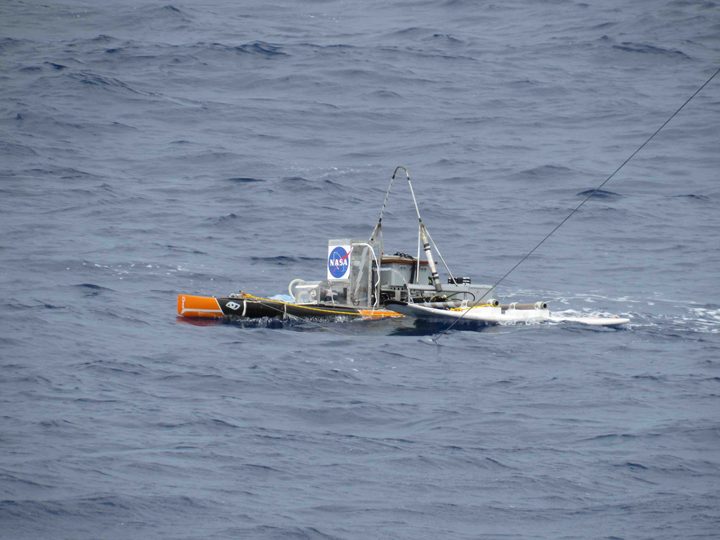
The Surface Salinity Profiler is towed outboard of ship wake using a special bridle.
The SSP is basically a re-purposed paddle board with an outrigger (surfboard) and a keel bristling with instruments. It looks a bit like a Frankenstein monster from a beach town surplus yard, but in actuality is a engineering marvel perfect for gathering data in the upper meter of the ocean.
In the year since we last deployed the SSP, more instruments have been added to improve its capability. It now has its own current profiler and improved turbulence (microstructure measurement) capability.
The SSP caused some heartache for a few days because of water leaking into the box containing the onboard computer. It is amazing to see the talent of many hands solving the problem. The box was completely disassembled, waterproofed, and reassembled (better than before) in less than 24 hours. Problem solved. It was a stroke of luck that the computer survived the moisture insult. However, the wifi capability from the SSP to the ship was lost, but that is not essential for successful data collection.
So, what is so important about gathering data in the upper meter of the ocean? This is where we find find buoyant freshwater from rainfall before it mixes down into the water column. Large areas of the tropical ocean have significant freshwater input. When seen from space these areas look very fresh – and no one suspected salinities so low because almost all other methods of profiling salinity in the tropics miss the upper few meters of the ocean. So, with SPURS-2 and SSP we get to resolve the apparent differences between what we see from space and what oceanographers “thought they saw” for decades. Both observations are correct – traditional oceanography had just missed the fresh layer close to the ocean surface! That puzzle is now solved and as science always does, it is now a matter of digging into the details! How does the freshwater from rain mix into the ocean. Does rain itself increase mixing or decrease mixing (oceanographers are hotly debating that question!)?
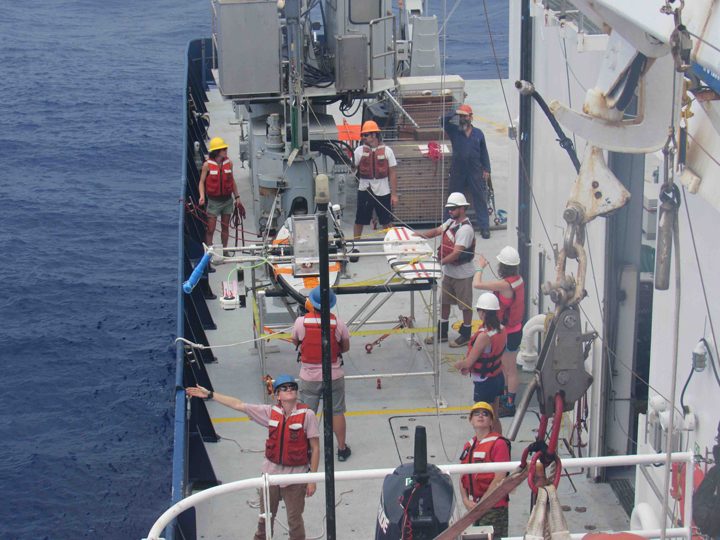
The SSP team preparing to launch the Sea Surface Profiler.
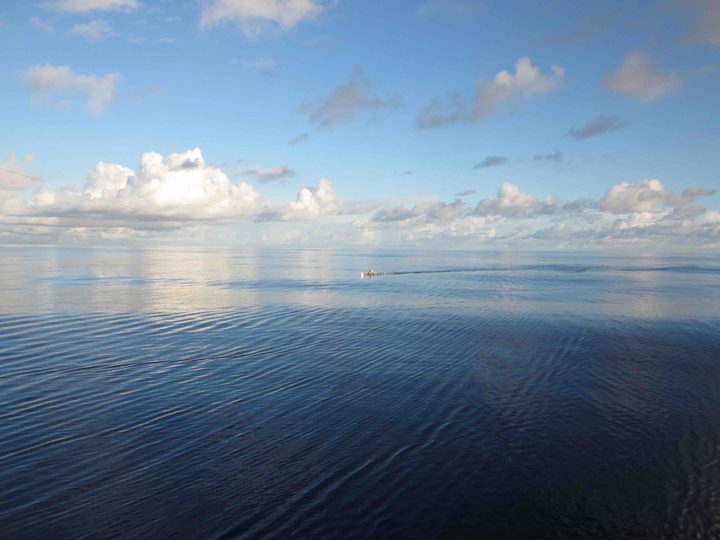
The SSP in calm sea – far from ship during full deployment.
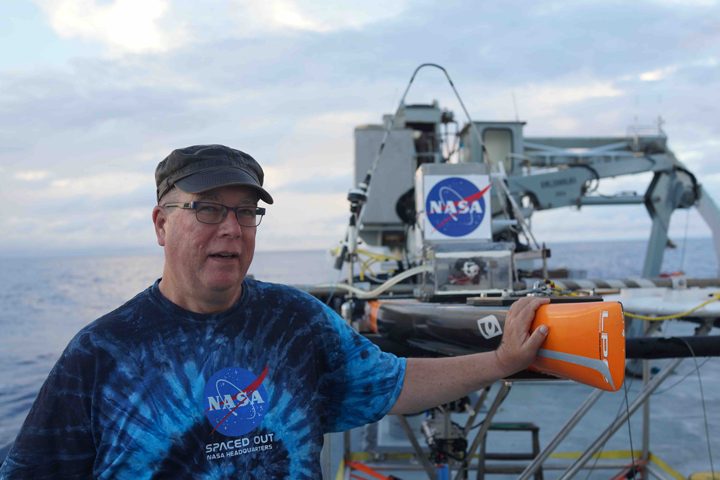
Eric Lindstrom with the Surface Salinity Profiler. Photo by David Ho.
Along with SSP, we profile salinity in the upper 500 m of the ocean about every 30 minutes using an Underway Conductivity, Temperature, and Depth (UCTD) profiler that can be deployed from the moving ship (and is) whether SSP is deployed or not. That instrument gives us the “traditional” large-scale view of the temperature and salinity field (salinity is derived by a formula from the conductivity and temperature of the water).
The are also a couple of thermosalinograph (TSG) systems built into the bow of the Revelle. They provide continuous data on temperature and salinity from water intakes at 2, 3, and 5 m depths.
Overall, there is much “integration” of various data sets required to assemble the full picture of salinity in the upper 5 meters of the ocean – using SSP, the salinity snake, thermosalinographs, UCTD, and detailed rainfall maps (future blog!). SSP plays the central role in untangling the physics of rain, ocean mixing, and salinity stratification.
Meanwhile, the egret pair appears to have adapted to life on Revelle.
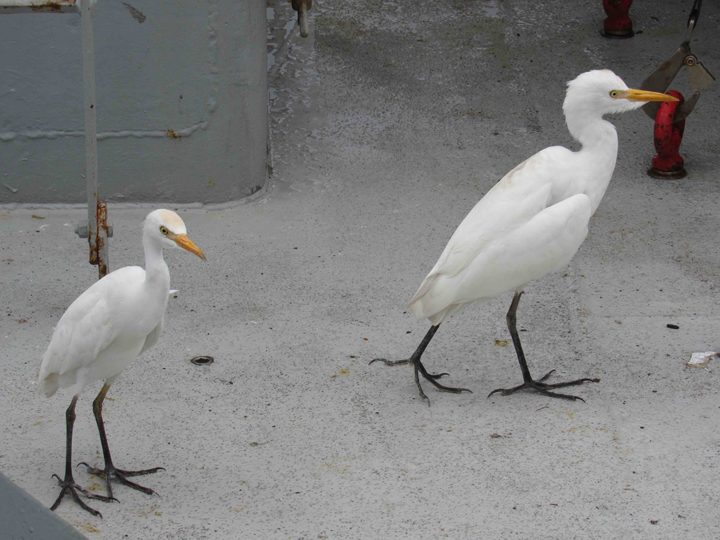
The egret pair has adapted to life on Revelle.
There is something about being at sea, totally surrounded by blue sea and blue sky that demands blogging about blue. I’ve done it before (see: The Moods of Sea and Sky; Shades of Blue) and from the looks of today’s blog, I’ve doing it again. Darn it.
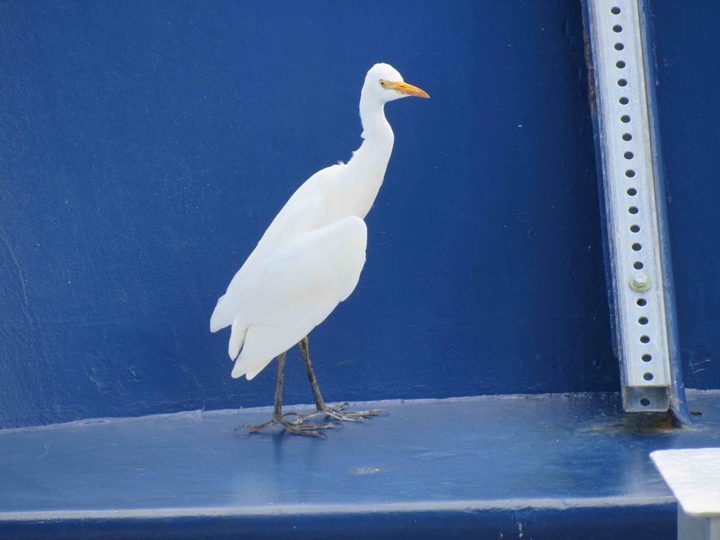
A Great Egret on the R/V Revelle at 10N, 125W.
It started this time with me thinking about blue birds – not literally a blue bird, but birds feeling lost and blue. Yes, that is probably stupid anthropomorphism, but it is the kind of conversation that gets going after weeks at sea. We have not one, but two, Great Egrets on the ship right now. I am sure they are very blue, even though they are perfectly white in color. Their usual home is possibly some cushy Florida suburban swamp stalking frogs and small fish. The summer is ending so they decide to head off to the other summer home in the Amazon, where you can snack on frogs and small fish. Then, bam! Some big wind comes along and all you can see day after blue day is blue sky and blue water. And this is likely some kind of Alice in Wonderland experience for a lost freshwater fowl – the fish are flying and the frogs look like sharks, and all of a sudden the water is 2 miles deep instead of 2 inches deep! Those long slim legs for wading are way too short now.
Now we have a tally of two “lost” species this voyage. The other, the Peruvian Booby, has “Boobied Up” and joined some sexy Blue-Footed Boobies for some hybrid action out over the horizon. Hey, that is a real thing, look it up!
I’m afraid there nothing we can do on Revelle for the Great Egret blues. I suppose they might tough out the steel decks and weird humans until San Diego and find some cousins at the Sea World ponds? Kinda depressing!
Really readers, blue is the color of oceanography! Well, at least when it is sunny. At night it is just black. If it is totally cloudy we might call the ocean “steely blue.” The sky then is, well, totally cloudy, and you guessed it, shades of gray. Isolated clouds are white, of course. How all the white clouds together become gray is a mystery (not really, but we are talking blue here today).
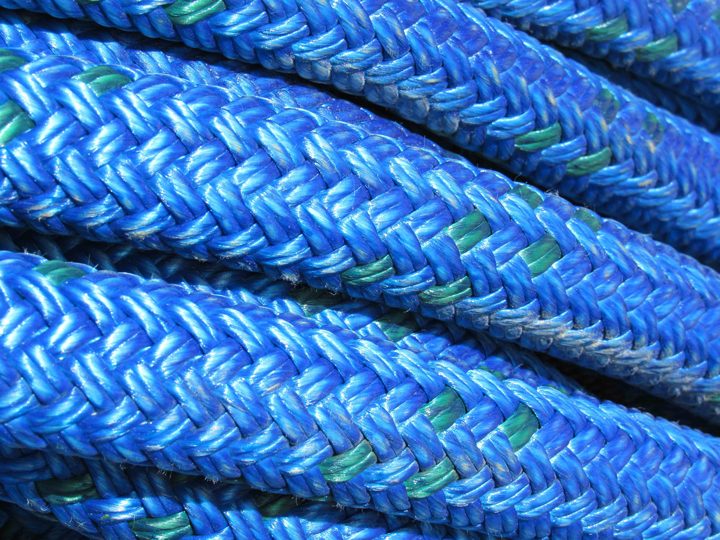

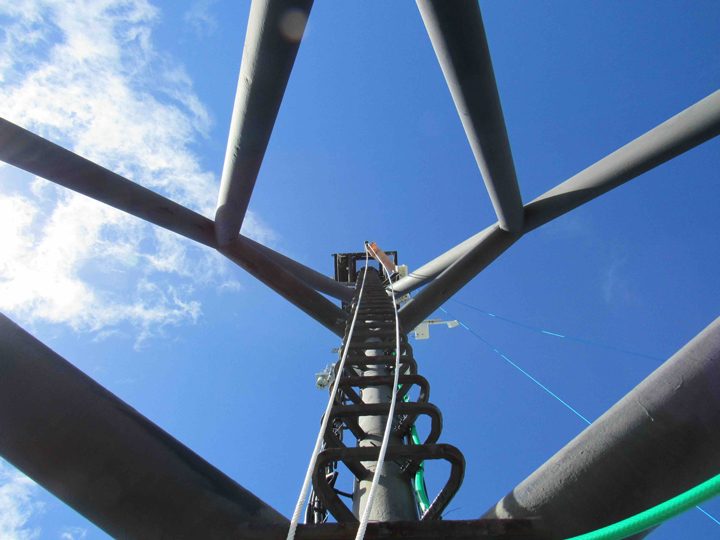
Rather than bore you with pictures of blue sea and blue sky today, I am sharing some more artsy photos in the blue theme. Its not hard to find such photos on a ship that is painted blue. I swear, a contrasting color would have been easier on the eyes! Take note UCSD. Could you go for a nice shade of puce?
Happy blues to all!